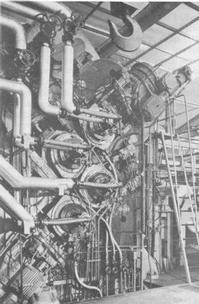


Chapter 9
I Introduction
II The Australian Chemical Industry
III Pharmaceuticals
IV Chemists In Other Industries
V The Dawn Of Modern Chemical Industry - High Pressure Synthesis
VI The Growth Of Synthetic Chemicals - Concentration, Rationalisation And International Links
VII Australian Industrial Chemical Research Laboratories
VIII The Plastics Industry
i Plastics processing
ii Phenol - basis of the first plastic
iii Plastics - the first generation
iv Plastics - the second generation - from petrochemicals
v Styrene monomer - the West Footscray petrochemical complex
vi The Botany petrochemical complex
vii The petrochemical complex at Altona
viii CSR - from sugar alcohol to petrochemical OXO alcohol
IX The Paint Industry
X Acknowledgements
References
Index
Search
Help
Contact us

Plastics processing
The plastics processing industry was an excellent vehicle for individual entrepreneurs; it offered scope for innovation and practical skills, it was a rapid growth industry and, at least initially, it was not too capital intensive. Many such small companies sprang up and prospered. The story of one of the most successful ones, Nylex Corporation, is typical.Like many of the other Australian industrial pioneering companies, Nylex[116] was the story of one family and a few key men. John Walton Derham came from an upper middle class Melbourne family. He was not academically inclined, as other distinguished members of the family were, and had no technical education, but he had drive and practical skill. During an early venture in the radio business, which failed, he became aware of the rapid growth of plastics -essentially 'Bakelite', phenolformaldehyde at the time. In 1927 he founded Australian Moulding Corporation and imported moulding powders. While most others imported finished products, Derham experimented with cheap second-hand equipment in moulding, learning the fundamentals from overseas journals. His first products were simple knobs, outer cases of radio receivers and the like. From imported finished products he learnt of new products such as urea-formaldehyde and finally PVC, and experimented with these. Soon competition started; Moulded Products (1931), Dunlop (South Melbourne, 1932), Associated Glass Manufacturers (1933) and a number of smaller companies followed. After some ups and downs, Derham was offered the opportunity to buy into Moulded Products. Rapid adoption of the new imported plastics -by the late thirties now including PVC from Germany and later the USA -and war-time demand provided opportunities for growth and adaptive innovation. Innovations developed by Nylex included PVC wire coating, moisture proof striking surfaces for matches and PVC copolymer solution for moisture-proofing rifles, all for the military services.
Peace, opening up better contact with international developments and machinery, and the growth of the industry, brought sophistication: large extruders, calenders (Fig. 24), plastic films, laminates, PVC hoses and wall papers. Know-how was partly imported, partly obtained from the major polymer producing companies, and partly generated internally by incremental innovation. The rate at which processors could adapt the new processes determined entry into the polymer manufacture. For this reason the larger companies, Monsanto, Shell, APC established technical service laboratories as did ICI Australia, side by side with their own Central Laboratories at Ascot Vale in 1959. In addition ICI deliberately entered the processing industry ('Visqueen' polyethylene film 1954) to promote the technology and the market.

Organisations in Australian Science at Work - A.P.C.; Associated Glass Manufacturers; Australian Moulding Corporation; I.C.I. Australia Ltd; Monsanto Australia; Moulded Products; Nylex Corporation; Shell Co. of Australia
People in Bright Sparcs - Derham, John Walton
 |
Australian Academy of Technological Sciences and Engineering |  |
© 1988 Print Edition pages 694 - 695, Online Edition 2000
Published by Australian Science and Technology Heritage Centre, using the Web Academic Resource Publisher
http://www.austehc.unimelb.edu.au/tia/662.html